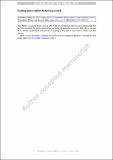Scaling limits of the Schelling model
Author(s)
Holden, Nina; Sheffield, Scott
Download440_2019_918_ReferencePDF.pdf (1.115Mb)
Open Access Policy
Open Access Policy
Creative Commons Attribution-Noncommercial-Share Alike
Terms of use
Metadata
Show full item recordAbstract
Abstract
The Schelling model of segregation, introduced by Schelling in 1969 as a model for residential segregation in cities, describes how populations of multiple types self-organize to form homogeneous clusters of one type. In this model, vertices in an N-dimensional lattice are initially assigned types randomly. As time evolves, the type at a vertex v has a tendency to be replaced with the most common type within distance w of v. We present the first mathematical description of the dynamical scaling limit of this model as w tends to infinity and the lattice is correspondingly rescaled. We do this by deriving an integro-differential equation for the limiting Schelling dynamics and proving almost sure existence and uniqueness of the solutions when the initial conditions are described by white noise. The evolving fields are in some sense very “rough” but we are able to make rigorous sense of the evolution. In a key lemma, we show that for certain Gaussian fields h, the supremum of the occupation density of $$h-\phi $$h-ϕ at zero (taken over all 1-Lipschitz functions $$\phi $$ϕ) is almost surely finite, thereby extending a result of Bass and Burdzy. In the one dimensional case, we also describe the scaling limit of the limiting clusters obtained at time infinity, thereby resolving a conjecture of Brandt, Immorlica, Kamath, and Kleinberg.
Date issued
2019-05-11Department
Massachusetts Institute of Technology. Department of MathematicsPublisher
Springer Berlin Heidelberg